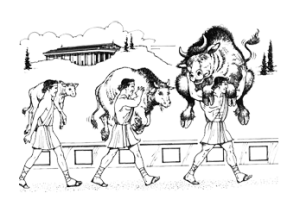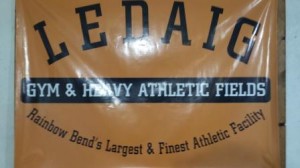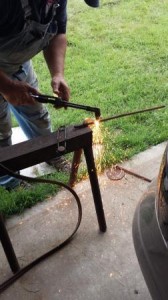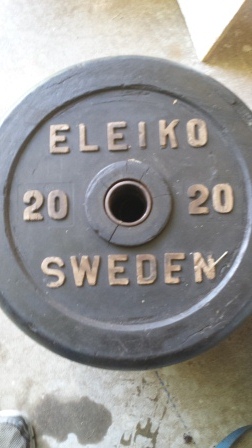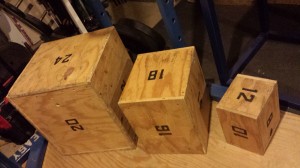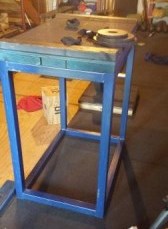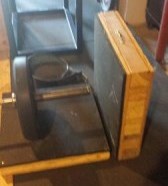To Kettlebell or Not
by Thom Van Vleck
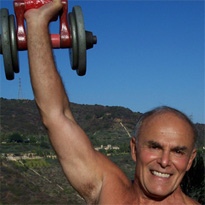
Here's a photo that shows a handle like the one that my grandfather used to convert his dumbbell into a kettlebell.
I work at a University and we have a rec center on campus. It’s a small school so the rec center is actually pretty decent for our size but still small. The guy that runs it has been there for 30 plus years and he is very upbeat and positive. Dan came out of the 70’s running craze and still runs to this day. Nothing wrong with that, but he’s not really a weightlifter and he knows it. I am a weightlifter and not much of a runner…so we keep each other balanced.
Dan tries to stay on top of the latest trends and has bought a handful of Kettlebells. They get used a great deal in the Osteoblasters “crossfit” style workouts that we have 4 days a week. We have a more traditional weightlifting group but the ratio is about 10 to 1 (the crossfit wins hands down). If you don’t know what that type of training is just imagine multiple stations where people move rapidly from one high rep, low weight or bodyweight exercise to another done in an open area and NOT in the regular lifting area) We have both been surprised at the success of the workouts. He likes the cardio aspect and I like the lifting aspect…..but neither of us would have guessed how well this would have went over. The problem is…we’re old and we don’t know what’s “in” these days. At least that’s the only explanation I can think of.
So we try and keep each other up to date on what’s “hot” in the fitness and lifting world. Dan wants to appeal to all the students including the students who lift heavy…like us. He asked me the other day if I thought he should get a set of Kettlebells for the gym. His concern is that the space is small and most of what he sees is people doing dynamic movements with them such as swings and flipping them to arms length. He’s worried about somebody getting conked on the head or a kettlebell going out a plate glass window. I’m worried NOBODY will use them enough to justify valuable gym space as the place is often packed! Plus that money could go for other things that would get used more often.
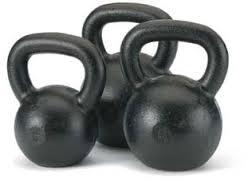
Here's what standard kettlebells look like.....as if you really needed to see them! But there are an ever increasing list of variations of them out there much like how the globe dumbbells became all different shapes.
Now you have to understand that me and Kettlebells go way back….well…sort of. I have never….EVER…trained with them. Sure, I’ve pulled them out and played with them and I even bought three of them for my gym that were close to the weights used in the highland games. Right now I’ve loaned them to the club because after I bought them and built a cool shelf to put them on….they were pretty much paperweights and novelties after that. Now before you Kettlebellers get your panties in a bunch let me go on.
My long relationship with kettlebells was that my grandfather had a kettlebell handle that went on a regular York 1″ loadable dumbbell making it a makeshift kettlebell. He also had some block scale weights that were kind of like using kettlebells. He would do high reps and sometimes would just grab it and do a few reps between chores around the house. My grandfather never trained to max out…always for fitness. He lived a very healthy and active life to the age of 85….when he was hit by a car! I think he would have live to be 100 and been one of those guys that would be in fantastic shape his entire life. But we all thought his lifting routine….especially the kettlebells was….uhhhhh….well….we called it the “fruitcake” routine because it seemed to have a little of everything and a lot of nothing and appeared thrown together most of the time. However, I think he may have had the last laugh.
So, what’s all this mean in regards to kettlebells. I told Dan that I thought they were a great idea to be used for the Osteoblaster workouts and we needed some more for the 45 to 90 people that show up for each workout. But as far as having a rack in the gym….so few would use it that it would be not worth it in my opinion.
There used to be a business supply chain centered locally that went out of business. It seemed to be a powerful business and I wondered why. I met someone that knew. He said his grandfather (who was the patriarch of the business) said, “Computers are just a fad…typewriters are where its at and where its always gonna be”. We can laugh now at that business decision but some of us older guys probably all had a typewriter at one time (Bill Clark still does). Kettlebells are kind of like typewriters in my mind. But again…before the kettlebell nuts get a screw loose…one more story. When I was in the Marines 30 years ago I copied Morse Code. We used teletypes (a cross between an electric typewriter and early computer) and actual computers. When the power went out….we pulled out our trusty “Royal” manual typewriters. I still have one in the closet in case I need to continue to write after the zombie apocalypse. So my point is, Kettlebells can be useful and every once in awhile pulled out for something different and they can be VERY useful in the crossfit type workouts. But their use is limited for those seeking pure strength and cannot, in my opinion, be a central part of your training like the dumbbell. The dumbbell….with the dumbest name next to the “Jerk” and “Snatch” (that’s another story altogether about stupid names in lifting) is still the Prince of the gym next to the King Barbell! Okay, I’m done and I’m sure there’s some kettle bell heads out there ready to burn my house down.
